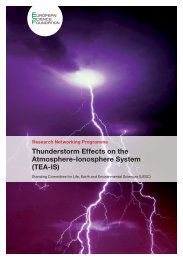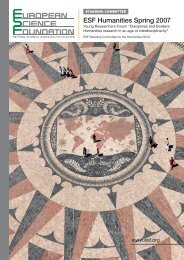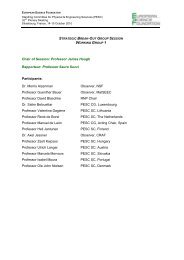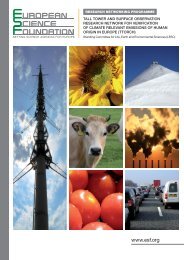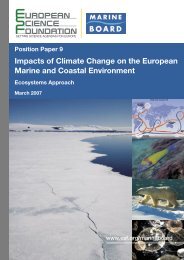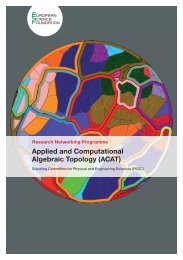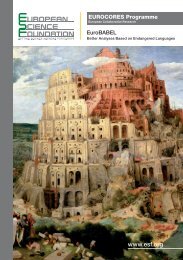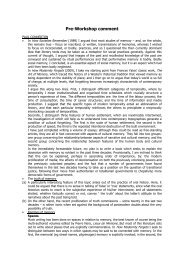European Peer Review Guide - European Science Foundation
European Peer Review Guide - European Science Foundation
European Peer Review Guide - European Science Foundation
Create successful ePaper yourself
Turn your PDF publications into a flip-book with our unique Google optimized e-Paper software.
course of developing a new research infrastructure<br />
there will typically be one or several steps where<br />
peer review will be used to assess a proposal asking<br />
for funding or for political support.<br />
This chapter will not deal with the whole process<br />
towards the decision to build a new RI. Instead<br />
it concentrates on the peer review steps included<br />
in the process, which are also applicable to small<br />
scale Research Infrastructures. In addition to the<br />
general aspects of peer review discussed in Part I, in<br />
this section some of the specific features relevant to<br />
selection of RI proposals will be indicated.<br />
9.2 Recommended peer review<br />
approaches specific to New<br />
Research Infrastructure proposals<br />
Research infrastructures are often of unique character<br />
and can be quite expensive, concerning both<br />
the costs of implementation and the running costs.<br />
Medium- to long-term commitments are in many<br />
cases required in order to recruit the staff, to maintain<br />
and renew equipment, to update databases and<br />
so forth. Thus, the establishment of RIs will typically<br />
not follow uniform procedures but is rather<br />
the result of complex, sometimes dedicated discussions<br />
on the needs and requirements of the research<br />
community.<br />
Moreover, infrastructures will often represent<br />
both nationally and internationally relevant investments.<br />
Sometimes, it will be critical to ensure that<br />
the review and evaluation should carefully consider<br />
how the projects align to <strong>European</strong> research agendas<br />
or national/<strong>European</strong> road maps, e.g., ESFRI,<br />
Joint Programming, etc. On the other hand, distributed<br />
RIs require special consideration of the<br />
collaboration and networking of the sites forming<br />
a research infrastructure while the costs of a<br />
part of the distributed RI might not be so critical.<br />
Information-based RIs might focus on adoption of<br />
accepted standards or working in close connection<br />
with similar RIs elsewhere.<br />
There are many other features that might play<br />
a significant role. Therefore it is difficult to establish<br />
merely a set of procedures covering all research<br />
infrastructures. However, some common elements<br />
can be identified that are strongly recommended<br />
to be part of any modern funding scheme, be it an<br />
open programme, a specific call, or even a tailormade<br />
process.<br />
• Any process towards the establishment of research<br />
infrastructures should contain a peer review step.<br />
Already within the initial steps towards the idea of<br />
a new research infrastructure one has to consider<br />
if the infrastructure will meet the needs of the scientific<br />
community and carry out an assessment of<br />
the scientific scope and (inter)disciplinary nature<br />
of the project. Regardless of how this stage of the<br />
discussion is conducted89, there should be a call for<br />
a detailed proposal. This is the moment at which<br />
peer reviewing is required to ensure the assessment<br />
and selection of the applications. <strong>Peer</strong> review<br />
will usually be the method of choice to measure<br />
the success of an established research infrastructure.<br />
• <strong>Review</strong> panels will be established with membership<br />
from scientific experts, active scientists and<br />
also experts in evaluating and/or managing infrastructures<br />
and large capital projects90. It might be<br />
reasonable to nominate members who would serve<br />
for designated periods if the future evaluation of<br />
the RI can already be foreseen. This would allow<br />
continuity, experience and competency to review<br />
infrastructural projects to be retained.<br />
• The review process will typically be based on a<br />
proposal indicating the scientific and strategic<br />
concept of the RI. The process may additionally<br />
offer the opportunity to discuss open questions<br />
with the applicants. The review panel would primarily<br />
assess the scientific merit of the application<br />
according to a well-defined set of critical criteria,<br />
as well as other review criteria as described<br />
below.<br />
• The review panel evaluation report will form the<br />
most important basis for the final selection of the<br />
proposal.<br />
• In addition to the review panel there is a decision<br />
board with membership different from the<br />
review panel. This decision board might consider<br />
additional aspects such as strategic goals, financial<br />
budgets and others. The discussion in the decision<br />
board would benefit from the evaluation report<br />
provided by the review panel.<br />
9.2.1 Timeline<br />
Like the Centres of Excellence, infrastructural<br />
projects, particularly those larger projects, require<br />
longer timelines for the whole decision process.<br />
89. It might be a competitive process selecting a proportion of<br />
projects for further evaluation which would already mean a peer<br />
review process on initial concepts. In other cases, individual or<br />
political decisions might determine the procedure.<br />
90. Though not in the focus of this chapter but for the sake<br />
of completeness, peer review will also be used in any cases<br />
of major updates or upgrades of existing RIs, for instance of<br />
instrumentation, databases, etc. Finally, peer review plays a role<br />
in assessing proposals submitted to RIs to get access to the RIs’<br />
resources.<br />
71<br />
<strong>European</strong> <strong>Peer</strong> <strong>Review</strong> <strong>Guide</strong>




